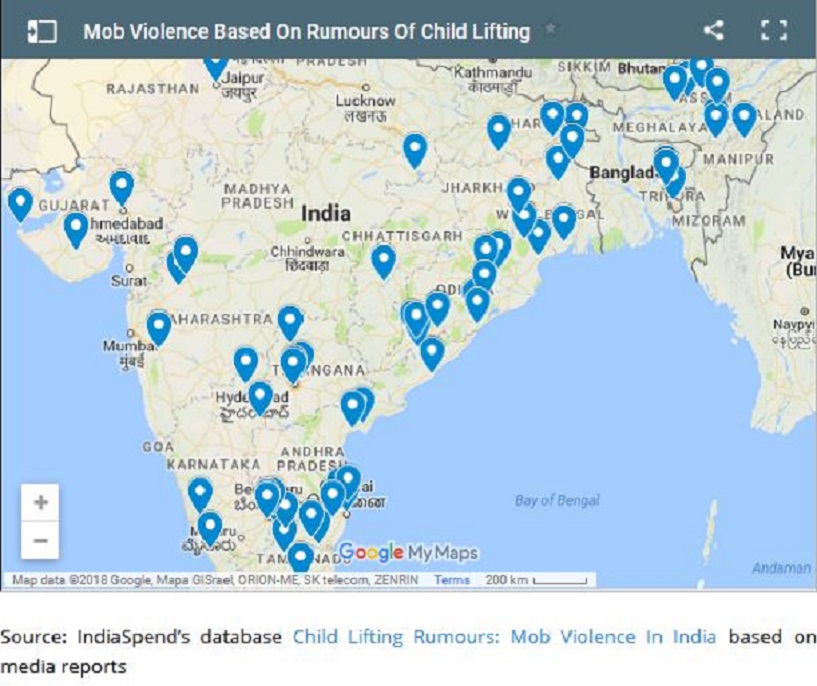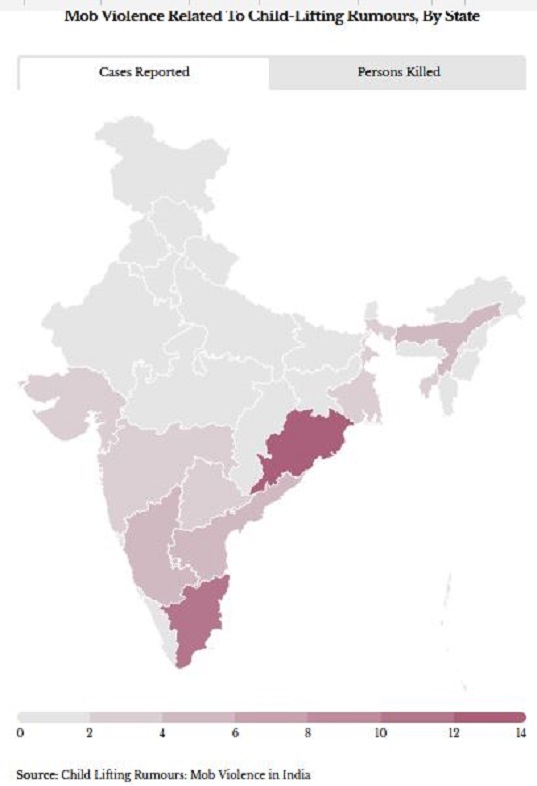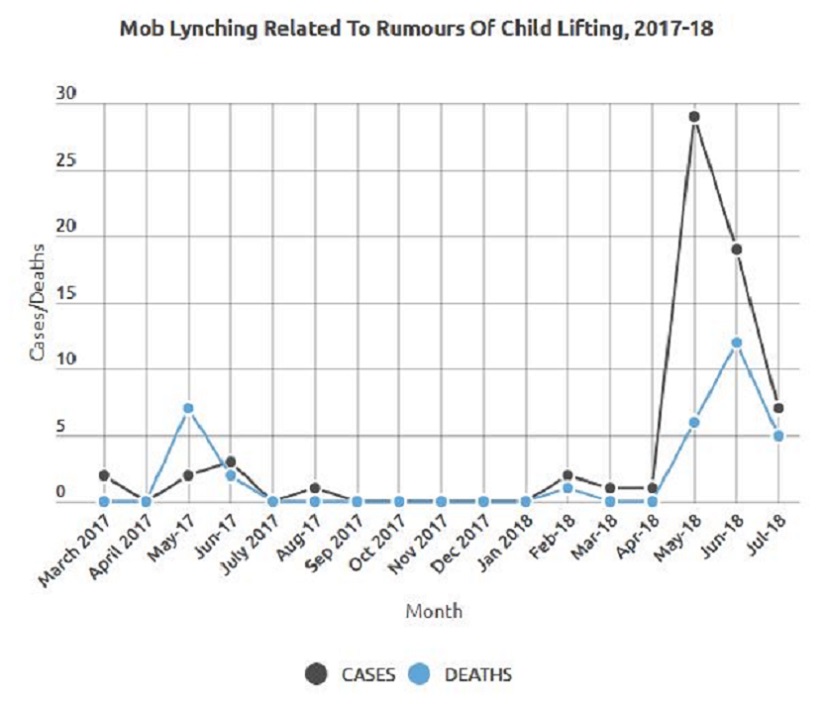Kidnapping, 'child lifting': India
Contents |
THE FACTS
The actual extent of ‘child-liftings’ in India
2014: State-wise statistics

See graphic, 'Victims of kidnapping and abduction in 2014 and recovery during the year, state-wise'
2014: Abduction of women, kidnapping
The Times of India, Aug 19 2015
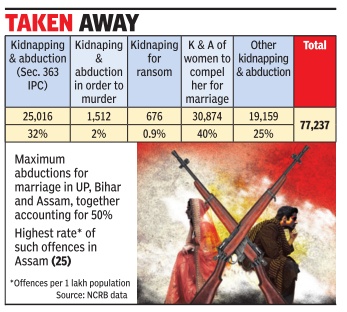
Deeptiman Tiwary
About 40% of all `abductions' are of women, for marriage: NCRB
`Ransom is no longer main motive'
Close to 40% of all `kidnappings' in the country are of women who are abducted for marriage. Latest data from the National Crime Records Bureau (NCRB), which has for the first time tabulated data on reasons for abduction, also suggests that ransom is no more a major motivation for the crime. The NCRB data for 2014 shows that of over 77,000 kidnappings that took place last year, only 676 had ransom as motivation. Close to 31,000 women were kidnapped last year with the intent to compel them for marriage. Over 1,500 people were kidnapped with an intent to murder them.
The data shows that UP, Bihar and Assam accounted for almost 50% of all kidnappings for marriage. Among these states, UP recorded the highest such offences with 7,338 cases of abduction of women. Such offences also made up almost 60% of all kidnappings in UP .
Bihar followed with 4,641 such cases. Marriage-related abductions accounted for 70% of all abductions in Bihar. Assam, which clocked 3,883 such cases, had the highest rate of such offences at 25 per one lakh of population.
Explaining the data, police sources said whenever a boy and a girl eloped for marriage, the girl's parents registered a complaint of kidnapping against the boy . This was the reason, they said, for such abnormally high number of kidnappings for marriage.
The highest number of ransom-motivated kidnappings were reported from West Bengal (101), followed by UP (83) and Bihar (62).
The highest number of kidnappings that ended up in murder were reported from Assam (632) followed by UP (539). UP led the chart in the category of total kidnappings with 12,361. MP took the second spot with 7,833 such cases.
2014-15: Motives for kidnapping
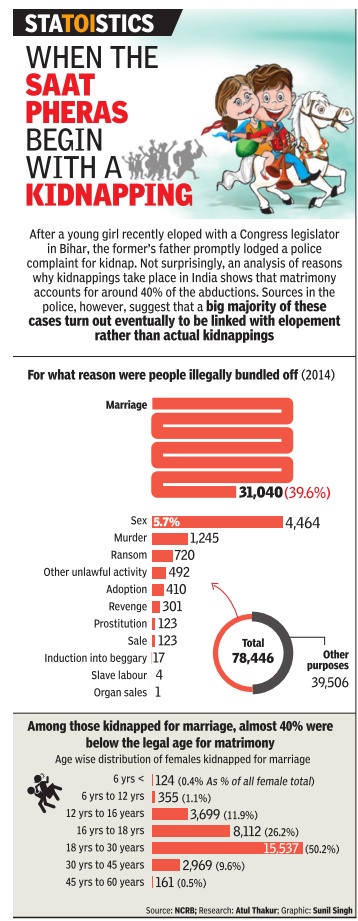
See graphic, ' Motives for kidnapping in India; presumably 2014-15 figures’
2016: 55,000 children kidnapped in India
Nearly 55,000 children kidnapped in India in 2016, says govt report |Jul 08,2018 |PTI
Charge sheets were filed in only 40.4 per cent of such cases with a conviction rate of 22.7 per cent.
Nearly 55,000 children kidnapped in India in 2016, says govt report
New Delhi: It seems that the fear of child lifting prevailing in different parts of the country is not completely unfounded, as nearly 55,000 children were kidnapped in India in 2016, a whopping 30 per cent increase over the previous year.
According to the 2017-18 report of the Ministry of Home Affairs (MHA), 54,723 children were kidnapped in 2016 but charge sheets were filed in only 40.4 per cent of the cases. The conviction rate in child kidnapping and abduction cases in 2016 was a dismal 22.7 per cent.
As many as 41,893 such incidents were recorded in 2015 and 37,854 in 2014. The figures for 2017 are yet to be published.
"Even though most of the lynchings in the recent past were fuelled by rumours of child lifting on social media, the statistics show that the fear of child kidnapping among people, especially those in the rural areas, is not completely unfounded," a ministry official said.
On Thursday, the Home Ministry had asked the states and Union territories (UTs) to check incidents of mob lynching fuelled by rumours of child-lifting on social media.
More than 20 people have been lynched over the last two months on suspicion of child lifting, the latest being the killing of five men in Maharashtra's Dhule district on July 1.
In an advisory, the ministry had urged the states and UTs to "keep a watch for early detection of rumours of child-lifting and initiate effective measures to counter them".
The MHA report also revealed that 8,132 cases of human trafficking were registered in the country in 2016. As many as 15,379 victims (5,229 males and 10,150 females) were trafficked and 23,117 victims (10,347 males and 12,770 females) were rescued. Of these victims, 22,932 belonged to India, 38 each were from Sri Lanka and Nepal and 36 were from Bangladesh.
The MHA report said 1,06,958 cases of crime against children were registered in the country in 2016 compared to 94,172 in 2015, an increase of 13.6 per cent. Crimes were committed against 24 per one lakh children in 2016, according to the report.
A major increase in crime against children was noticed (in 2016) under "human trafficking, kidnapping and abduction, Protection of Children from Sexual Offenses (POCSO) Act and Juvenile Justice Act", the report said.
RUMOURS
Child-lifting rumours and subsequent mob attacks/ lynchings
2017-18, June: An IndiaSpend study
45 persons were killed in 40 cases of mob lynching across nine states between 2014 and 3 March 2018 according to data
Two incidents of mob violence reported from Dima Hasao in Assam and Mangaluru in Karnataka on July 6, 2018, take to 61 the number of mob attacks sparked by rumours of child-lifting circulated on social media since beginning of the year.
So far this year, 24 persons have been killed in such mob attacks, an IndiaSpend analysis of news reports from across India shows. This is more than 4.5 times rise in attacks and two-fold rise in deaths of this kind over 2017, when 11 persons were killed in eight separate attacks.
Between January 1, 2017, and July 5, 2018, 33 persons have been killed and at least 99 injured in 69 reported cases. In the first six days of July alone, there have been nine cases of mob violence over child lifting rumours and five deaths, which amounts to more than one attack recorded every day.
In all cases, the victims were assaulted on mere suspicion and no evidence of child lifting was found later. So far, police across states have arrested at least 181 persons in connection with 21 cases, according to information from the news reports.
On July 5, 2018, the central home ministry had directed all states and union territories to contain mob-lynchings fuelled by rumours of child-lifting on social media. Nevertheless, two attacks were reported on July 6, 2018–a father travelling with his own son in Karnataka, and three sadhus or ‘holy men’ travelling in Assam.
See graphic, ' Mob Violence Related To Child-Lifting Rumours, By State: Persons killed '
See graphic, ' Mob Violence Related To Child-Lifting Rumours, By State: Cases reported '
Prior to 2017, one mob lynching was recorded in August 2012, in which a driver was killed in Patna, Bihar, on suspicion of kidnapping a minor, according to our database.
The spike in these lynchings over the past year follows a rise in bovine-related hate violence, as recorded in IndiaSpend’s database on cow-related hate crime. Incidents of mob attacks on persons suspected of killing cows have become deadlier during this period, with more deaths reported in attacks.
Social and political commentators have blamed this violence on a rise in socio-political and religious cleavages, a rise of vigilantism and an apparent atmosphere of impunity for attackers.
“The violence started with cow-related vigilantism but it is now building up more violent behaviour–from small to big reasons anything could be the trigger,” psychologist Upneet Lalli, deputy director of the Institute of Correctional Administration in Chandigarh, told IndiaSpend.
Videos of people tied and beaten, begging mobs to spare their lives, have been circulating on WhatsApp groups and other social media, affecting people everywhere, she said, adding, “Once set off for any reason, mob hysteria is extremely difficult to control.”
Social media is aiding and abetting the process, criminologist Vijay Raghavan, dean of the social protection office at the Tata Institute of Social Sciences, told IndiaSpend, adding that the growing violence is “clearly being orchestrated by vested interests”.
“A rumour starts in one part of the country and travels to other parts like wildfire–first it was beef, now it is child lifting,” he said. In most cases, the victims and the attackers belong to communities historically pitted against each other, he said, “This changing narrative has a clear pattern of violence that is basically preying on traditional insider-outsider perceptions.”
IndiaSpend’s analysis
To analyse instances of mob violence related to child-lifting rumours, our team collected, studied and cross-verified print and online news reports in the English media, which tend to have the widest nationwide coverage, since 2010. All reported incidents were cross-referenced to eliminate discrepancies.
The dataset thus created includes the number of mob attacks, the severity of each attack and details of the victims. Most entries include the names of districts, towns and villages.
Since each observation is based on a newspaper report of the crime, availability of details such as the severity of crime, the number of victims and their identities and ethnicities varies.
Before 2017, only one incident was reported in 2012.
Jharkhand, Maharashtra deadliest
Among all states and union territories, Jharkhand and Maharashtra, with seven and five deaths, respectively, reported the highest death toll. The chances of death in such attacks in these states stood at 350% and 167%, respectively, meaning every reported incident led to more than one death.
Odisha, under the Biju Janata Dal government, reported the most number of attacks, 15, which resulted in one death. Tamil Nadu, run by the All India Anna Dravida Munnetra Kazhagam (AIADMK), followed with nine cases and four deaths.
One-third or 30% of attacks were reported from states ruled by the Bharatiya Janata Party, which also runs the central government.
In the 19 months since January 2017, 10 districts across 16 states have reported more than one case of mob violence. Jeypore, Mayurbhanjh and Rayagada in Odisha and Visakhapatnam in Andhra Pradesh have reported three separate incidents each.
More than half or 56% of the attacked victims were men, 22% women, 3% transgender, and for the remaining 18%, the gender was not mentioned in the news reports.
Among those killed, 14 were Hindus, 3 Muslims, and in 16 cases the religious/ethnic identity was not reported.
No correlation between rise in reported child kidnappings and spread of mob violence
Except in Maharashtra, these incidents of violence do not reflect an increase in child kidnapping cases recorded in National Crime Records Bureau (NCRB) data from 2014 to 2016.
In the two years from 2014, India recorded a 41% rise in kidnapping and abduction of children–from 38,555 in 2014 to 54,328 in 2016–primarily in Uttar Pradesh (9,678), Maharashtra (8,260) and Delhi (6,254), NCRB data show.
As of 2016, Maharashtra, the second-most populous state in India, reported the second-highest number of child abductions. It has also reported the second-highest toll from mob lynchings over child-lifting rumours.
However, there was no such correlation in Uttar Pradesh and Delhi, which the NCRB ranked first and third for the number of reported child abductions and kidnappings (which are defined differently in law but basically involve seizing by force and against the victim’s will).
Jharkhand, which reported the highest death toll from mob lynchings, ranked 19 across India for reported child abductions in 2016, as per NCRB data. Tripura, where five people were killed, ranked 24.
This may suggest that fears of child lifting are unfounded and exaggerated. “There is no correlation because the instigators of this violence are not prompted by a genuine fear of kidnapping,” Raghavan said.
However, the data do not account for cases that go unreported–families are hesitant to approach the police, who are seen to be unsympathetic and intimidating–or cases lost in communication between states and NCRB.
The violence is also indicative of how people have lost faith in law enforcement and criminal justice systems to act decisively against child lifting, Lalli said, adding, “Losing faith in the law of the land is a serious threat to society.”
Mob psyche is different from individual psyche, she said, “When an individual acts, there is a sense of responsibility, but in a mob, there is a dispersion of responsibility and guilt.” The mob justifies its act as heroism to save the community, their identity, their children, themselves.
Mob-Lynching Over Child Lifting Rumours And Official Data On Child Abductions
|
Mob-<a href="https://www.business-standard.com/topic/lynching" target="_blank">Lynching Over <a href="https://www.business-standard.com/search?type=news&q=child+lifting+rumours" target="_blank">Child Lifting Rumours And Official Data On Child Abductions |
|||
|
State |
Mob Violence Related To Child-Lifting Rumours |
Deaths In Mob Lynchings Related To Child-Lifting Rumours |
Ranked As Per Number Of Child Abductions Recorded In NCRB Data |
|
West Bengal |
4 |
3 |
5 |
|
Tripura |
3 |
3 |
24 |
|
Telangana |
4 |
4 |
15 |
|
Tamil Nadu |
12 |
4 |
18 |
|
Rajasthan |
1 |
1 |
10 |
|
Odisha |
15 |
1 |
13 |
|
Manipur |
1 |
0 |
27 |
|
Maharashtra |
4 |
5 |
2 |
|
Madhya Pradesh |
1 |
0 |
4 |
|
Kerala |
1 |
0 |
22 |
|
Karnataka |
6 |
1 |
8 |
|
Jharkhand |
2 |
7 |
19 |
|
Gujarat |
3 |
1 |
7 |
|
Chattisgarh |
1 |
0 |
9 |
|
Assam |
6 |
3 |
11 |
|
Andhra Pradesh |
5 |
0 |
16 |
|
Total (all- India) |
69 |
33 |
|
End of table
Of the children kidnapped or abducted in 2016, 73% were female and 27% male, NCRB data show. Of the total child victims, 31% (16,938) were kidnapped or abducted for the purpose of marriage, of which only one victim was male; 3% (1,562 female and 26 male) for illicit intercourse; and 1% each for other unlawful activity and adoption. No purpose was mentioned in fully 62% of cases.
77% attacks attributed to fake news
Of the 69 mob violence cases related to rumours of child lifting that have been reported, 77% were eventually attributed to fake news spread through social media. Mobile messenger application Whatsapp, in particular, featured as the rumour source in 28% or 19 of the cases.
The ministry of electronics and information technology on July 2, 2018, issued a warning to Whatsapp, observing that “instances of lynching of innocent people because of large number of irresponsible and explosive messages filled with rumours and provocation are being circulated on WhatsApp”.
“Such a platform cannot evade accountability and responsibility especially when good technological inventions are abused by some miscreants who resort to provocative messages which lead to spread of violence,” the ministry said subsequently in a press release on July 3, 2018, stating clearly that “WhatsApp must take immediate action to end this menace and ensure that their platform is not used for such malafide activities”.
About 13% or 200 million of WhatsApp’s 1.5 billion users are Indian, The Financial Express reported on February 1, 2018. This is 42% of India’s 481 million internet users recorded as of December 2017.
In a letter to the ministry shared with IndiaSpend, the WhatsApp management said it was “horrified by these terrible acts of violence” and listed out the steps it has taken to curb the spread of fake news but emphasised that the challenge “requires government, civil society and technology companies to work together”.
It maintained, however, that messages would continue to have end-to-end encryption to protect users’ privacy and security, encryption being key to WhatsApp’s messaging service. It added that no more than a quarter of WhatsApp users are part of groups; that the majority of groups are small (with fewer than 10 members); and nine in 10 messages are sent from just one person to another.
Cyber privacy experts caution against overreacting against WhatsApp and other social media platforms, arguing in favour of free speech and privacy.
In June, after two cases of mob lynching in Tripura, the government tried to control the situation by shutting down the internet in the area, reports included in our database said.
This is “a slippery slope to quell dissent”, Swaraj Barooah, director at the Centre for Internet and Society, a Bengaluru-based not-for-profit, said, adding, “There are indications that marginalised groups tend to be affected more strongly than others when there are internet shutdowns.”
Lynchings point to a much larger issue than the ubiquitous presence of social media, experts said. “Everyone is focusing on these being rumours–and of course the platform’s ability to exponentially magnify the speed and reach of a message being sent is very relevant–but when and why did we normalise vigilante justice in the first place?” said Barooah. “For instance, would this type of action be okay if these were not rumours, but had actually been true?”
“The root problem is those exploiting historical animosities between communities. We need to properly investigate on a national-level who are the instigators and what are they after–merely arresting people after an incident is not enough,” professor Raghavan said.
Barooah also warned against attempts to force WhatsApp to provide security agencies with decrypted data, as the government had forced the Canadian smartphone maker Blackberry to do in 2013.
“Given that it is already unsure of the extent to which WhatsApp shares metadata with governments, it is important to ensure that its end-to-end encryption facility is not weakened,” Barooah said. “There are certain delicate trade-offs that can be made, but if they are, they should not be made as a knee-jerk reaction to ongoing events but after careful consideration of all the pitfalls. This is especially important in India, given the lack of a privacy law as well as concerns of chilling effects on free speech that are present.”
Some solutions he suggested include making it mandatory that WhatsApp forwards and memes contain originator details, and that a “fact check this” option be inserted at the user end to allow a message to be decrypted. He also suggested that a database of ‘reported hashes’ be created, which all users could download, and which would automatically rate messages on ‘trust’.
It is also important to help people identify fake news and question the information they receive, experts say, pointing out that while India has low literacy and education levels, even highly literate people are not free from confirmation bias.
“We really need to educate people–people naively believe everything they read as true. We’re not doing anything about critical thinking and critical inquiry–we’ve stopped being questioning and that’s a very important part of countering fake news,” Lalli said, adding, “We don’t even respond to information, we’re only reacting.”
How recent attacks tie in with bovine-related vigilantism and violence
IndiaSpend has been maintaining a database of bovine-related violence since 2010, which shows a spurt in violence since the BJP and Prime Minister Narendra Modi assumed power in May 2014.
A preponderant majority of bovine-related hate crimes–98% of the 85 incidents–have occurred since May 2014, our database shows. Only one incident each was reported in 2012 and 2013.
Around 56% of the persons attacked by these groups were Muslim, who accounted for 88% of those killed in this violence. In 2018, 100% of victims attacked in these hate crimes were Muslim.
“There is a clear increase in aggression by one group against the other and a growing inability to empathise and understand those different from ourselves,” Lalli said, “This has essentially made us revert to behaving like tribalistic societies with animalistic instincts–where, when for survival, when you perceive an animal to be a threat, you attack it to kill it.”
In more than a third–28 of 85 incidents–mobs or groups of people were spurred into violence on the mere suspicion of cow slaughter.
Our database also shows that the attacks have become deadlier–the percentage chance of such mob-violence resulting in death has more than doubled from 30% in 2017–regarded as the deadliest year since 2010 (11 deaths in 37 cases)–to 66% in 2018 (four deaths in six cases).
“Society has an innate capacity for violence and it’s very easy to encourage this. Right from Twitter trolling–which is basically extreme verbal aggression–we are unleashing and encouraging violence in different ways and contexts,” Lalli said.
What the government says
Many commentators have remarked that the absence of a strict and prompt response from the government has encouraged such violence. “What action is taken when such cases occur has an important bearing on the continuation of such violence,” Raghavan said, “By not taking strong action, the state is complicit in its orchestration.”
“While we hear about more incidents of violence, we are yet to hear full recognition or condemnation of these acts from the important leaders–in a way it sends out a message that does not discourage the mob,” Lalli agreed, “When you don’t speak out about it and come down on it strongly, it sends out a signal to society that it’s alright to resort to violence for these reasons since nobody gets punished.”
The NCRB “does not maintain specific data with respect to mob lynching incidents (involving minorities) in the country”, the home ministry told Parliament on March 13, 2018.
The ministry did furnish some data on mob lynchings recorded by states from 2014 to 2017, but did not provide information on the motive–whether cow vigilantism, communal or caste hatred, or rumours of child-lifting, etc. The data also did not disclose the identity of the victims.
These data said 45 persons were killed in 40 cases of mob lynching across nine states between 2014 and March 3, 2018. At least 217 persons have been arrested.
In contrast, IndiaSpend’s two databases on mob violence–due to child-lifting rumours and bovine-related hate violence–record 80 cases and 41 deaths during the same period. This is without counting other instances of mob violence related to caste, moral policing and so on.
(Saldanha is an assistant editor with IndiaSpend. Rajput, a masters student of journalism at Mumbai University, and Hazare, an economics graduate, are interns with IndiaSpend.)
Lynchings in India, 2017- 2018
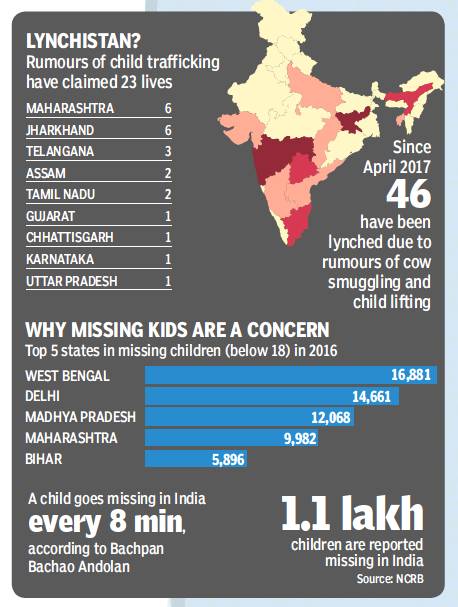
From: July 22, 2018: The Times of India
See graphic:
Lynchings in India, April 2017- July 2018
2018, June: 14 people killed in lynchings
In June this year alone, 14 people have been killed in lynchings, two each in Assam, Andhra Pradesh, Tripura, Maharashtra, West Bengal, Telangana and one each in Gujarat and Karnataka.
Maharashtra To Tripura, Child Lifting Rumours Continue To Fuel Lynchings
A mob in Maharashtra's Dhule district lynched five men on Sunday suspecting them to be child-lifters, following rumours circulated on social media that a gang trafficking children were on the prowl.
According to reports, the mob armed with stones and sticks surrounded the five men in Rainpada, a tribal village about 400km northeast of Mumbai, around 11am and assaulted them. Advertisement opens in new window
The men, who were said to be from the state's Solapur district, were locked in a room after the initial assault and thrashed again. They died of their wounds later.
Police said on Monday that 15 people were arrested for the fatal attack.
READ ALSO: Fear is trending and violence is a ping away, why does fake news make India erupt?
The Dhule attack follows another mob assault on two men — both migrant contractual labourers — on Monday in Chennai over rumours that they were trying to kidnap a child. The case emerged after a video of the attack surfaced on social media. A man was arrested and police are searching for another suspect seen in the video.
This was the latest in a spurt in mob violence following rumours on social media in the past several months, leading to assaults and murders. One of the first cases was reported from Obanapalle village in Andhra Pradesh on April 28 when locals thrashed a mentally unsound man to death. Advertisement opens in new window
This was followed by the brutal lynching of two friends – Nilotpal Das, 29, and Abhijeet Nath, 30, in Assam’s Karbi Anglong district after they were mistaken as child-lifters by a mob of more than 200 people in June.
READ ALSO: Nilotpal Wanted To Promote Assam Through Music, Abhijeet Never Even Hurt An Insect, Say Friends Of Mob Lynching Victims
A woman was lynched in Vadaj on June 27 after a mob labelled her a child-lifter and overturned the autorickshaw she and two other women were travelling in.
In another case, Sukanta Chakraborty, 36, who was appealing to the public on behalf of the administration to refrain from rumour-mongering on social media, fell victim on Thursday of mass hysteria over child-lifting that has claimed two lives and left as many as six people injured in three separate cases in the past 48 hours, forcing the Tripura government to suspend all mobile Internet services for two days. Advertisement opens in new window
"Sukanta Chakraborty was attacked when he was appealing to the public on behalf of the administration not to heed to rumours. Senior officials have rushed to these areas and additional security has been deployed to control the situation," an official told reporters.
A few hours before Chakraborty's death, a mob of nearly 1,000 people attacked four traders from northern Uttar Pradesh, killing one and leaving the others critically wounded.
The four took refuge inside a paramilitary camp after hundreds of people believing them to be child kidnappers chased their vehicle after they stopped for a tea break on a road.
On the same day, a mob set upon an unidentified woman after she was spotted by residents walking around their village, Das said.
The woman in her 40s was beaten with batons and dragged across the village as tribal residents chanted "death to child lifters", police said.
In view of rumour-mongering, Uttar Pradesh director general of police Akhil Kumar Shukla issued a notification on Thursday, suspending all SMS and Internet services for the next 48 hours. Advertisement opens in new window
"It has been noticed that SMS, WhatsApp and social media platforms like Facebook, Twitter and YouTube are being widely used for transmission of fake images, videos and text messages which have the potential to incite violence in the state," the notification stated.
On April 28, another mentally unstable man was hacked to death by a mob in Vellore district in Tamil Nadu after several WhatsApp posts claimed that around 200 miscreants from “north India” had either entered or were entering the state to abduct children.
READ ALSO: Child-Lifting Rumours Reach Tripura, 2 Lynched Within 24 Hours Despite Govt Warnings, Internet Suspended
Two more similar mob attacks were reported from the state within two weeks.
The recent cases have a pan-India reach and impact. Child-lifting rumours have claimed lives from Assam to Tamil Nadu because of rumours floating on social media platforms such as WhatsApp. In June this year alone, 14 people have been killed in lynchings, two each in Assam, Andhra Pradesh, Tripura, Maharashtra, West Bengal, Telangana and one each in Gujarat and Karnataka.
(With Agency Inputs)
Kidnapping by a parent
HC: No ‘kidnapping’ if father takes away child from mother
Vaibhav Ganjapure, Nov 3, 2023: The Times of India
NAGPUR: If a man takes away his minor son from the mother’s custody, it does not mean he kidnapped him, the Nagpur bench of Bombay HC said.
The biological father cannot be booked for kidnapping under the IPC in such cases, if a competent court had not granted the minor’s custody to the mother, a division bench comprising Justices Vinay Joshi and Valmiki Menezes ruled.
Quashing the FIR lodged by a woman against her husband, the court said: “Natural father of the minor is also a lawful guardian along with the mother. Therefore, he cannot be said to have committed the offence under section 361 to be made punishable under section 363.”
The father’s move just amounted to taking the child from one “lawful guardianship of the mother to another lawful guardianship of the father”, the judges observed.
“So long as there is no divestment of the rights of guardianship of a father, he cannot be held guilty of an offence under section 361,” the bench ruled.
The father moved the high court after Amravati police booked him for kidnapping after his wife lodged a complaint that he had forcibly taken away their three-year-old son on March 29.Quoting section 6 of the Hindu Minority and Guardianship Act, 1956, the judges said for a Hindu minor, the father is a natural guardian, and after him, the mother. “It is abundantly clear that the petitioner is a natural guardian of a minor in absence of an order otherwise passed by a court of competent jurisdiction,” the bench said.
Holding that prima facie, kidnapping case is not made out, the HC said under such circumstances, continuation of prosecution would amount to “abuse of the process of the court”.
The judges said for a Hindu minor, the father is a natural guardian and after him, the mother.
THE LAW
Death Sentence for kidnappers
Come down hard on kidnappers: SC to judges
Says Death Sentence Okay Even If Murder Not Involved
Dhananjay Mahapatra | TNN
From the archives of The Times of India 2007, 2009 2010 feb
New Delhi: Taking serious note of the spate of kidnappings for ransom across the country, Supreme Court on Wednesday asked judges to punish kidnappers hard, mentioning that the law allows awarding death sentence in exceptional cases of kidnapping for ransom even if they did not involve murder.
“Statistics reveal that kidnapping for ransom has become a lucrative and thriving industry all over the country which must be dealt with in the harshest possible manner and an obligation rests on courts as well,” a bench comprising justices H S Bedi and J M Panchal said on Monday.
The remark, which may herald a tough regime of justice for kidnappers, came as the top court upheld death penalty on two men who kidnapped a 16-year-old DAV school student from Hoshiarpur for ransom and later murdered him.
Abhi Verma, son of goldsmith Ravi Verma, was kidnapped on February 14, 2005, from outside his school in Hoshiarpur by Vikram Singh, who made several ransom calls to the father. When police got on their trail, Vikram, his accomplice Jasvir Singh and the latter’s wife Sonia killed the boy by using chloroform and then injecting him with an overdose of lethal drug.
The plans for the killing were finalized in front of the child and this is what moved the court to impose death penalty on Vikram and Jasvir, though it reduced the capital punishment awarded to Sonia by trial court and the high court to that of life sentence.
Justice Bedi, writing the judgment for the bench, said, “We must emphasise that in this tragic scenario in the drawing up of the balance sheet, the plight of the hapless victim, and the abject terror that he must have undergone while in the grip of his kidnappers, is often ignored.”
Attempting to paint the picture of a victim in a case of kidnap for ransom, the bench said, “Take this very case. Abhi was only 16 years old, and had been picked up by Vikram who was known to him but had soon realized the predicament that he faced and had shouted for help.” It added, “His terror can further be visualized when he would have heard threatening calls to his father and seen the preparations to kill him, which included taping his mouth and the administration of an overdose of dangerous drugs. The horror, distress and the devastation felt in the family on the loss of an only son, can also be imagined.”
No mercy could be shown towards Vikram and Jasvir, the bench said upholding the death penalty to them. However, it decided to impose life sentence on Sonia saying she might have got embroiled in the conspiracy with her husband and Vikram on account of having come under their pressure.
Punishment
SC: No life term for kidnapper if hostage is well looked after
Dhananjay Mahapatra, June 30, 2021: The Times of India
The Supreme Court has ruled that If a person kidnaps a child for ransom but looks after the minor well and does not threaten to kill or harm him to extract release money from his parents, then he could not be sentenced to life imprisonment under section 364A of the Indian Penal Code.
Analysing the law and relevant judgments, a bench of Justices Ashok Bhushan and R Subhash Reddy on Monday said, “we conclude that the essential ingredients to convict an accused under section 364A which are required to be proved by prosecution are as follows: (i) Kidnapping or abduction of any person or keeping a person in detention after such kidnapping or abduction; and (ii) threatens to cause death or hurt to such person, or by his conduct gives rise to a reasonable apprehension that such person may be put to death or hurt or; (iii) causes hurt or death to such person in order to compel the government or any foreign state or any governmental organisation or any other person to do or abstain from doing any act or to pay a ransom”.
Referring to the stringent punishment of life or death sentence provided for convictions under section 364A, the bench said, “In addition to the first condition either condition (ii) or (iii) has to be proved (against the accused), failing which conviction under section 364A can’t be sustained.”
In the case in hand, an auto driver had kidnapped a sixth class student in Secunderabad, on the pretext of dropping him home. He had taken the child to his home and demanded a ransom of Rs 2 lakh. The child was rescued by decoy policemen when the child’s father went to pay the ransom money. In their deposition before the trial court, the child and his father said the kidnapper treated the boy well and he never threatened to kill or harm him. But, the trial court and the HC convicted the driver and sentenced him to life imprisonment. The driver challenged the sentence on the ground that there was no threat to the hostage’s life.
In their deposition before the trial court, both the child and his father said that the kidnapper treated the boy well and he never threatened to kill or harm him
